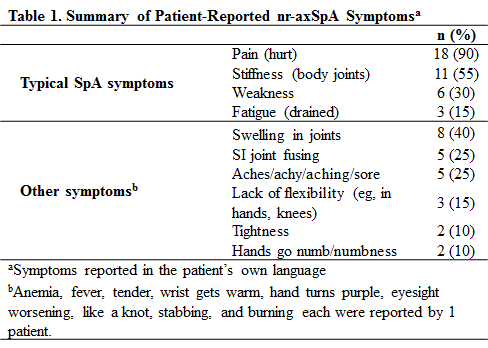Session Information
Session Type: Abstract Submissions (ACR)
Background/Purpose: Pain, physical function impairment, and health-related quality of life (HRQoL) impact are substantial for patients with non-radiographic axial spondyloarthritis (nr-axSpA).1 Understanding the most important aspects of nr-axSpA from the patient’s perspective may offer insights regarding the relevance of the disease specific patient-reported outcome (PRO) instruments and lead to better disease assessment and management in this patient population. We explored the impact of nr-axSpA on patients’ physical function and other HRQoL outcomes and assessed content validity for 3 commonly used PROs.
Methods: In this cross-sectional cognitive interview study, participants ≥18 years old with chronic back pain and physician-diagnosed nr-axSpA were interviewed at 4 US sites in the Midwest/West. Participants were asked open-ended questions regarding their nr-axSpA symptoms including frequency, severity, and effect on their lives. Participants then completed and were interviewed with the Bath Ankylosing Spondylitis Functional Index (BASFI), Bath Ankylosing Spondylitis Disease Activity Index (BASDAI), and Health Assessment Questionnaire–Spondyloarthropathies (HAQ-S).
Results: Among the 20 participants, mean age was 42.8 years, 45% were women, 85% were white, and mean duration of nr-axSpA was 3.5 years. The majority (90%) reported pain (table), which tended to increase in intensity during flares and as patients aged. Other symptoms—most notably stiffness, weakness, swollen joints, problems with the sacroiliac (SI) joints, and aches—were also mentioned. The most common physical functioning and HRQoL impacts were associated with sleeping, walking, athletic activity, bending, sitting for long periods, and household chores. Mean scores on the PRO measures were 4.7 (range of 0.52–8.85) for BASFI, 4.85 (range of 1.13–8.31) for BASDAI, and 1.09 (range of 0–2) for HAQ-S. The cognitive interviews suggested that HAQ-S covers key symptoms and effects of nr-axSpA and the majority of the participants found the items clear and relatable to their condition. The interviews also suggested overall relevance of the BASFI and BASDAI in nr-axSpA, but symptoms and difficulties such as swollen joints, SI joint problems, aches, and sexual/emotional aspects may not be addressed fully.
Conclusion: This study highlights patients’ perspectives of their nr-axSpA symptoms. Pain and other symptoms such as stiffness and joint problems often caused significant impairment in the participants’ daily lives. The findings strongly support the relevance of the HAQ-S, BASFI, and BASDAI in the nr-axSpA population. Future studies could explore whether additional items or modification to wording and response options, as suggested by the participants, could enhance the measures or lead to the development of new measures.
Reference: 1Sieper J, et al. doi:10.1136/annrheumdis-2012-201766.
Disclosure:
P. J. Mease,
AbbVie, Amgen, BMS, Celgene, Genentech, Janssen, Lilly, Merck, Novartis, Pfizer, Roche, UCB,
5;
S. A. Rao,
AbbVie,
1,
AbbVie,
3;
A. D. Joshi,
AbbVie,
3,
AbbVie,
1;
S. Clifford,
United BioSource Corporation,
3;
C. Vernon,
United BioSource Corporation ,
3;
M. A. Cifaldi,
AbbVie,
3,
AbbVie,
1.
« Back to 2013 ACR/ARHP Annual Meeting
ACR Meeting Abstracts - https://acrabstracts.org/abstract/quality-of-life-physical-function-and-symptoms-in-non-radiographic-axial-spondyloarthritisthe-patient-perspective/

